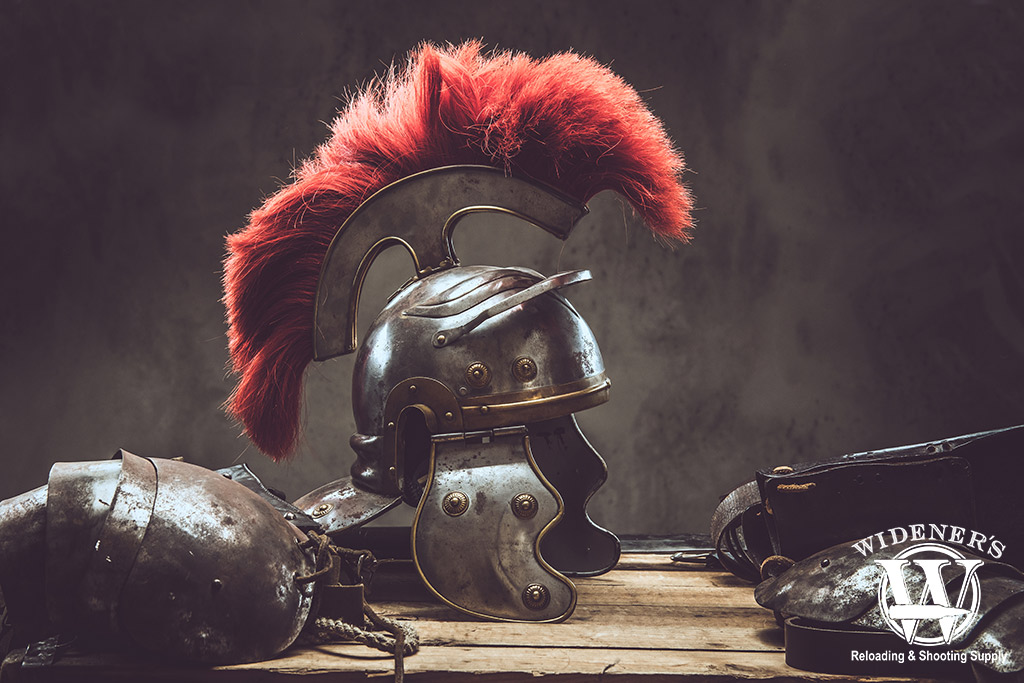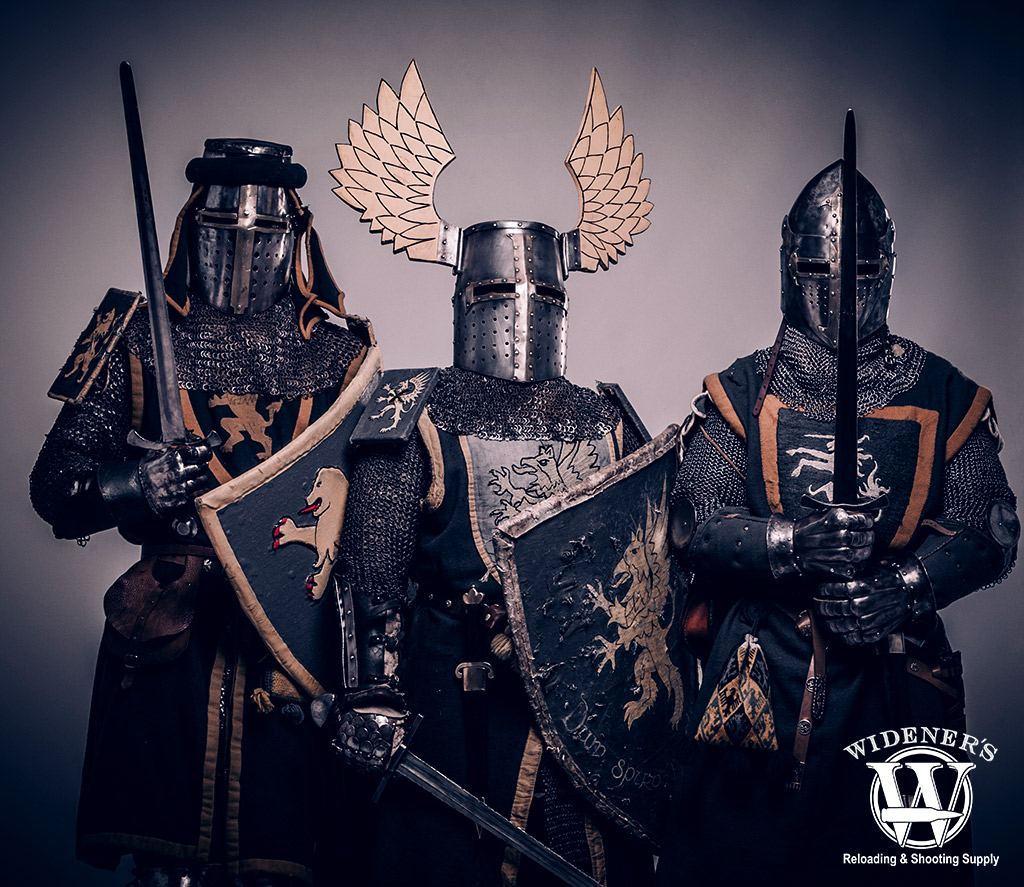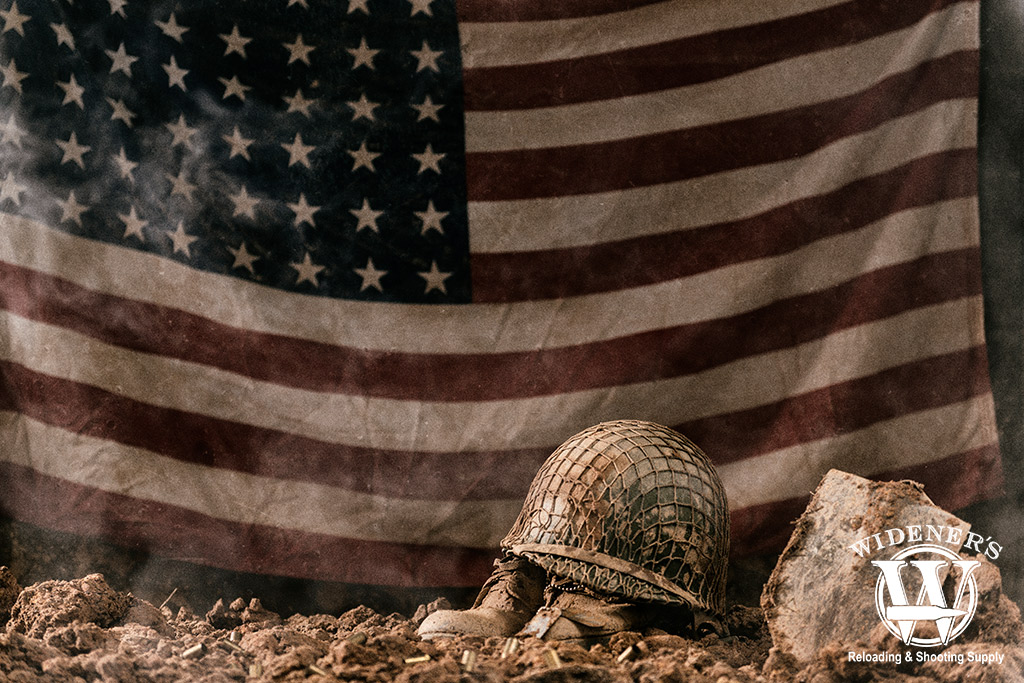
Naturally, many people would think of body armor as some new technology. Perhaps recently invented to protect modern-day men and women in both the armed services and law enforcement. The truth is, however, that the development of arms and armor began with the start of humanity.
Throughout recorded history, and before that, the earliest warriors employed a variety of materials for personal protection. The idea was to protect against injury in combat, hunting, and other dangerous situations. Rudimentary body armor consisted mainly of protective clothing and shields made from animal skins.
At some point, warriors fashioned shields from wood and much later, from metal. Much of the information on early armor is largely a matter of conjecture. It wasn’t until Homer wrote his epics, around 750 BCE, that there are detailed descriptions of shields, greaves, helmets, and breastplates that provide insight into the archaic body armor of ancient Greece.
Grecian Hoplite Armor
A hoplite was a type of heavily armed and armored foot-soldier in Greece. Hoplites fought for Greece in the 7th to 4th centuries BCE. Much of their protection came from a leather-lined bronze helmet. It safeguarded their head, neck, and face. A corselet (or breastplate), made of bronze or leather, shielded their torso. They would also wear bronze greaves for shin protection and would sometimes wear arm guards.
Add a 30-inch-diameter shield made of wood and leather with a bronze facing and an 8-foot-long spear, along with a short sword, and these citizen-soldiers were carrying around 45 pounds of arms and armor. An incredible feat of physical endurance for soldiers moving on foot.
Armor of the Roman Empire

Roman armor protected against projectiles such as spears, arrows, swords, and daggers.
Roman soldiers of the B.C. and A.D. centuries had a clear advantage over their barbarian enemies, especially when it came to torso armor. While not all troops wore torso armor–light infantry, for instance, wore little or no armor to allow for quicker movement–for those who did wear it, there were several types in those early centuries. Here are two of the most common ones:
Lorica Segmentata Armor
By the first century A.D., during the reign of Emperor Tiberius, lorica segmentata armor had begun to replace previous styles. The new armor had greater flexibility, lighter weight, and was easier to manufacture. This style of armor consisted of four sections: two for the shoulders and two for the torso. They fastened the iron or steel that provided protection to leather straps inside. The metal strips ran horizontally on the body and overlapped downwards. The armor surrounded the torso in two halves. The wearer fastened it at the front and back.
Lorica Squamata Armor
The lorica squamata was a type of scale armor used by Roman soldiers during both the Roman Republic (509 BC to 27 B.C.) and the Roman Empire. It was made up of small iron or bronze scales wired to each other and fastened onto a backing fabric. The thin scales overlapped in every direction, giving superior protection to the wearer.
European Armor of the Middle Ages

European plate armor reached the height of its popularity during the late 15th and early 16th centuries.
In medieval Europe, large plate armor would replace the hardened leather, chainmail, and thin plates of earlier centuries. The development of larger bloomeries in 14th century Italy made it possible to produce large steel plates in one piece, and by 1400, a full harness of plate armor was being manufactured in the armories of Lombardy, Italy.
During the Middle Ages, blacksmiths perfected the art of making carburized iron, which had a surface layer of steel, and these plates were virtually impenetrable. Not only that, but the plate armor required less labor to manufacture, so they became less expensive.
They still used chainmail to protect the joint areas—elbows, groin, and armpits—since plates couldn’t properly protect them. One of the biggest advantages of the plates was that a lance rest, which allowed the mounted warrior to hold the lance firmly contained under his right arm, could be attached to the breastplate. But things were about to change.
Chinese Alchemists Change Warfare
While conducting experiments on life-lengthening elixirs around 850 AD, Chinese alchemists instead discovered gunpowder. Not only would gunpowder make warfare very different, especially in the way battles were waged, but it would have a profound effect on the use and usefulness of body armor.
During the Sung dynasty, the Chinese used their invention to fight their Mongol enemies. The Chinese lit an arrow affixed with a tube of gunpowder and fired it across enemy lines. This resulted in the term “flying fire.” But it wasn’t until the 13th century, when traders along the silk trade route to Europe passed the science to Europe, that it became a factor in Middle Age battles.
By the middle of the 14th century, rudimentary cannons were common in the English and French militaries. The new weapon had the power to render the traditional walled fortifications of Europe, along with its body armor, weak and defenseless.
Heavily armored cavalry had dominated the battlefield for centuries, but by the early 15th century, developments in weaponry were now enabling infantry soldiers to defeat armored knights. Armor had to be thicker, which, in turn, required militaries breed larger cavalry horses.
Not only were these horses compelled to carry the weight of their rider’s armor, but many of them had their own protective armor, which was called barding. While armor in the 14th century weighed a little over 30 pounds, by the late 16th century, it had increased to about 55 pounds. The extra thickness and weight gave it substantially more endurance.
Gunpowder, Muskets and the West
The Chinese discovered gunpowder in the 9th century, but it didn’t make its way to the West until the 13th century. Eventually, this led to the development of the musket in the early 1500s. At first, the traditional types of armor offered enough protection, even if they weren’t one hundred percent projectile-proof. There were all sorts of melees that didn’t involve muskets, so the body armor of the Medieval era hung around until about 1650.
Decline In Popularity During The 1700s
Why didn’t armies wear body armor as much after 1650? It probably had more to do with cost than any other reason. Up until the second half of the 17th century, mercenaries made up armies. Now, national armies replaced these mercenaries. The armies eventually grew to a point where expensive armor was no longer affordable to provide for the troops.
The rationale became that soldiers were more likely to die from disease, artillery, or starvation than from a musket ball or bayonet. So, militaries abandoned traditional armor, not because it was ineffective, but because it wasn’t effective enough to warrant the expense.
Body Armor and the American Civil War
Neither side considered body armor standard military equipment during the Civil War. Neither the Union nor Confederacy issued armor to their troops. But that didn’t stop several manufacturers from producing armor soon after the war began. One of them, the G&D Cook Company of New Haven, Conn., introduced body armor made with two steel plates that were joined in the center and supported by hooks that were secured over the shoulders. A cloth waistcoat covered the steel plating and looked like a Union soldier’s uniform.
The armor vests produced by the Atwater Armor Company, Cook’s competitor, used four attaching steel plates. Like the Cook model, two broad hooks secured the vest over the shoulders. There were belts at the waist to provide for a tighter fit.
At first, armor sales were brisk. Soldiers believed advertisements proclaiming the resilience of their vests. However, the vests were heavy. The vests added ten pounds to the fifty pounds of standard equipment—and its value was limited. While some had stopped long-range bullets, most rounds fired at close range went clean through, taking remnants of the vest with them.
Soldiers quickly became disillusioned with the heavy gear. On one occasion, a New Hampshire troop reportedly marched through Washington in October 1862, stopping near the White House. Having marched in heavy bullet-proof vests from their home state, the fatigued men removed them and tossed them into the gutter. They declared they would rather face Southern bullets than carry the gear any farther.
Ned Kelly’s Body Armor
In 1879, Australian outlaw, Ned Kelly, made news headlines throughout Australia and much of the world. He and other members of the Kelly gang created their own suits of body armor to battle the police. They created the armor from scrap metal and forged it together using crude blacksmithing techniques. Despite the armor, most of the Kelly gang died during the ill-fated siege against the police. Ned was later tried, convicted, and hung by the neck until death.
Body Armor During The World Wars

Believe it or not, soldiers didn’t widely use body armor during WWI or WWII.
World War I
When the First World War began in 1914, you could not find armor on the battlefield. It wasn’t until late 1915 that British soldiers were issued steel helmets, but in that same year, the British Army designers introduced the Dayfield body shield, a canvas jacket with layered metal plates.
In 1916, the German army came out with “Lobster” armor made of nickel and silicon plates. While body armor was never universally issued by either side, soldiers’ families usually purchased and paid for it. And both sides used the captured armor of the enemy.
Eventually, Britrish troops used three main types of armor:
- Rigid ‘hard’ armor made of metal plates sandwiched between fabric and worn as a vest
- Intermediate armor with small square plates of metal attached to a canvas support
- Soft armor made of layers of silk, cotton, and linen scraps sandwiched in a fabric waistcoat
At the end of the war, British army medical services estimated effective armor could have prevented 75% of all battlefield injuries.
World War II
Militaries didn’t widely use body armor during World War II. In the early years of the war, military planners didn’t prioritize their development. But as the war went on, it became apparent that certain types of troops needed body armor.
In 1940, the first modern form of body armor emerged. The British began issuing armor vests made of manganese plates to their anti-aircraft and naval gunners. Because they protected against low-velocity projectiles, while allowing the wearer to move around, they were very popular.
The bombing campaign in Europe pushed the development of body armor quickly. Top brass realized that shrapnel, rather than bullets caused most of the injuries to bomber crews. This led to the development of the first “flak jacket,” which was made of nylon.
Modern body armor, however, would have to wait until the final year of the war. The U.S. developed bullet-proof vests made of Doron Plate, a type of fiberglass laminate finally arrived. Tank crews initially used vests that included these plates in the Battle of Okinawa in the spring of 1945.
Vietnam War Body Armor
Even though body armor was readily available in Viet Nam, few soldiers wore it, especially while patrolling. It was bulky and trapped heat and moisture. Soldiers in in static defensive positions and non-armored vehicle convoys mainly wore it.
When body armor was used, the M-1955 and M-69 flak vests were standard issues. Similar in appearance to the older model M-1955, the M-69 weighed 8.4 pounds and consisted of twelve layers of ballistic nylon filler, sealed in a waterproof casing.
During the Vietnam War, the intense ground fire prompted the army to start issuing body armor made specifically for helicopter crews and other aviators. Not surprisingly, pilots did not embrace it. Its 18.5-pound weight, the restrictions it placed on movement, and the high temperatures made it an unpopular piece of gear.
Scientific Breakthrough: Kevlar
The biggest advance in body armor came in 1971 when Kevlar arrived on the scene. It was an eye-opener. When it was woven and layered into a fabric, it had five times the tensile strength of steel, all the while being flexible and lightweight.
Law enforcement adopted the K-15 Kevlar vest in 1975. It consisted of 15 layers of Kevlar and included a steel plate that protected the heart. By the 1980s, around half of law enforcement officers wore Kevlar vests, and they saved many of their lives. By 2006, estimates credited body armor with saving 2,000 lives in the police force.
Modern Body Armor

We rate modern body armor from levels I-IV based on performance standards of bullet resistance.
Those Kevlar vests continue to form the basis of most modern body armor. But it’s important to point out that no vest is going to stop every bullet or projectile. You’ll have to make a compromise between mobility and protection. In today’s warfare, leadership expects troops to be active. Wearing truly “bullet-proof” vests would be an impediment. The body armor issued to service-personnel today can offer various levels of protection.
Body Armor Protection Levels I-II
- Basic Level I – Protects against rounds up to .38 Special that travel below 850 fps.
- Level IIA – Protects against rounds up to 9mm full metal jacket that travel below 1090 fps.
- Level II – Protects against rounds up to .38 Special, 9mm, .40 S&W, .45 ACP in FMJ that travel below 1175 fps. Also, offers protection against .357 Magnum soft point rounds up to 1395 fps.
Body Armor Protection Levels III
- Level IIIA – Can stop the above plus 9mm, .357 Sig, and .44 Magnum JHP rounds traveling up to 1400 fps.
- Level III – Can protect against 7.62×39 FMJ and .308 Winchester FMJ with a velocity of up to 2750 fps
Body Armor Protection Levels IV
- Level IV – Protects against all of the same caliber rounds as the lower levels. Also protects against most .30 caliber rounds like .30-06 up to .30 M2 AP rounds with a velocity of up to 2850 fps. Also protects against larger and faster-traveling fragments than other body armor levels
But the most recent forms of body armor are, in some cases, providing less protection than those of fifty years ago. The extra mobility makes up for the decreased protection—or so the theory goes.
Body Armor of the Future
In the future, materials with names like Dyneema, Twaron, Dragon Skin, and Zylon promise even greater protection from projectile penetration than Kevlar. These materials could be part of standard body armor soon.
Looking toward the distant future, the U.S. military is reportedly working on body armor that makes use of rheology–a technique that is used to produce elasticity in skincare products and certain automotive devices. Could armored exoskeletons and mech-suits be far behind? It’s more possible than ever with the convergence of smart technology and wearables.
No matter what the future holds, there are no signs of body armor becoming obsolete. In fact, it’s now easier than ever to own body armor as a civilian. Many civilian body armor manufacturers offer armor solutions that would have been unaffordable even a decade ago. Since those long-ago days of the hoplites, armor has been evolving, improving, and becoming more available. It’s no wonder body armor has become an increasingly vital part of many citizen’s personal protection equipment.

